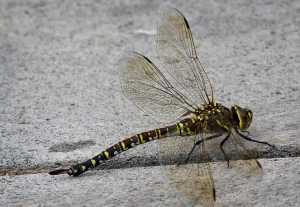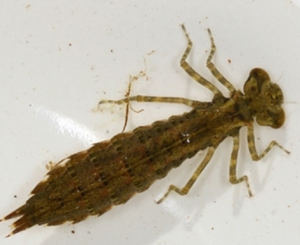Variable Darner Dragonfly: Did You Know?
[separator headline=”h3″ title=”From Prehistoric to Modern Times”]
Dragonflies were some of the first winged insects to evolve some 300 million years ago. Modern dragonflies have wingspans of 20 mm to 19 cm, but in prehistoric times dragonflies were much larger, the largest flying insects ever. The largest member of the extinct Protodonata was the Permian Meganeuropsis permiana with a wingspan of 70-75 cm. That’s the size of a hawk!
Odonates, which comprise the dragonflies and damselflies, are among our largest insects with body lengths up to 75 mm.
Dragonflies are in the sub-order Anisoptera (“unequal-winged”) and their major characteristics are:
• Hind wings are shorter and broader than fore wings.
• Usually larger, strongly-flying insects often observed flying well away from water.
• At rest, they hold their wings out from the body, often at right angles to it.
• Eyes are very large and usually touch, at least at a point.
• Larvae have no external lamellae.
The Variable Darner Dragonfly does not go through complete metamorphosis like the Monarch butterfly (Danaus plexippus); the life stages of the dragonflies and the damselflies are egg, larva, and adult. The Monarch butterfly has an additional stage: the pupa.
In their larval stage, which can last several years, dragonflies live in lentic water and eat just about anything—tadpoles, mosquitoes, fish, other insect larvae and even each other. After a series of moults, the nymph crawls out of the water usually in the early morning when it is safest from predators, then its exoskeleton cracks open and releases the dragonfly’s abdomen, which had been packed in like a telescope. Its four wings come out, and they dry and harden over the next several hours to days. The adult is a voracious predator, as it was as a nymph, and will eat just about any insect it can capture in flight, including mosquitoes.
The Variable Darner is named for its thoracic stripes. The males stripes are either very narrow or broken in the middle into pairs of spots, whereas the females are marked with blue, green, or yellow.
This Darner is found into the boreal forest from Alaska and the Yukon Territories east across Canada to Nova Scotia, extending south to California, New Mexico, and northern New York. They can be found near lakes, ponds, and marshes.
The adult flight season is early June to October. They fly late in the day, often until dark.
Male Darners establish and defend territories along the shores of ponds and marshes. After males and females mate, females fly singly, without the male attached, to lay their eggs on the stems and leaves of aquatic plants.
[separator headline=”h3″ title=”How They Fly: Dragonflies Defy Evolution”]






